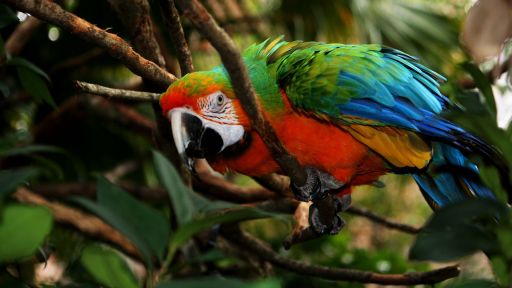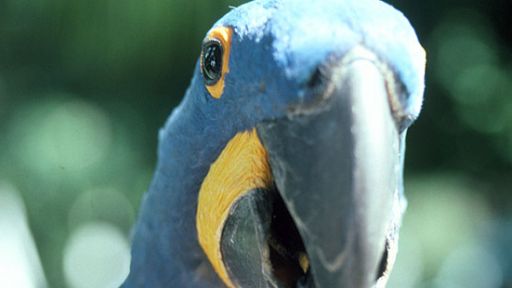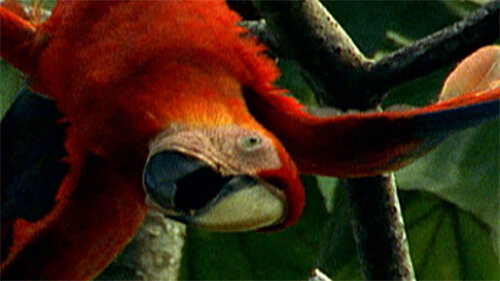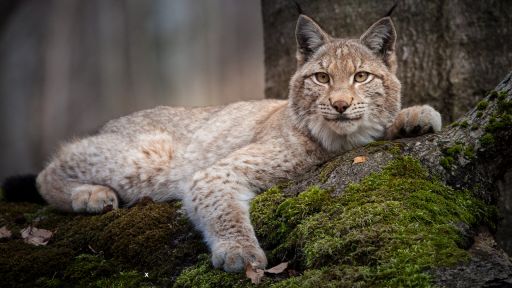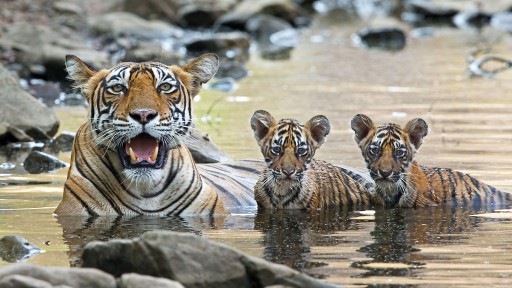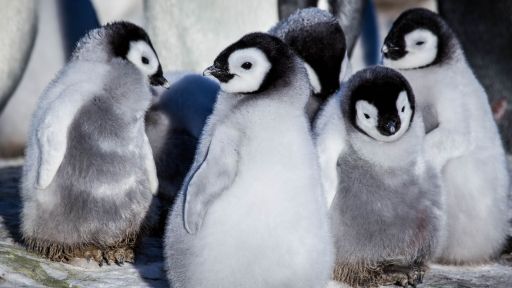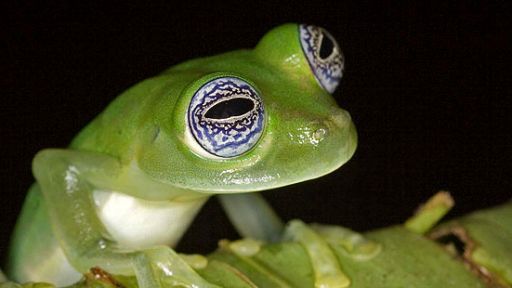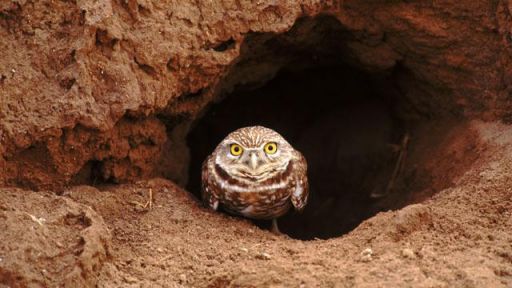TRANSCRIPT
[Light music] NARRATOR: Macaws, the most dazzling of all parrots, attract fans that become fanatics.
Parrots are boisterous, naughty, playful, intelligent.
( whispering ): The local people sometimes don't understand why we would spend thousands of dollars and go through all of this just to come see a bird.
MAN: My friends tell me that I'm actually part macaw.
NARRATOR: But all this devotion has a dark side.
Thousands are smuggled from the wild each year.
I guess I'll call the bird dealers and tell them we're in town and having a drink and just about to join them.
( gunshot ) NARRATOR: But one man is putting his money where his heart is.
Military macaw!
MAN: For a macaw fanatic like me, this has got to be seventh heaven.
NARRATOR: He's betting big that instead of buying birds, their fans will follow them to the rain forests, [Epic Music] THIS PROGRAM WAS MADE POSSIBLE BY THE CORPORATION FOR PUBLIC BROADCASTING AND BY CONTRIBUTIONS TO YOUR PBS STATION FROM VIEWERS LIKE YOU.
THANK YOU.
McGILLIN: When Tony Juniper, the director of Friends of the Earth, has any spare time, he's out pursuing his passion for macaws.
He's come to Tenerife's Loro Parque to find out why we love them so much.
If you need any evidence about how popular these birds really are, then just look around inside this room.
Hundreds of people from all over Europe come in here to see the parrot show-- surely the biggest attraction at Loro Parque.
People lining up day after day to come and see these spectacular creatures perform.
TRAINER: i¡Arriba!
( parrots squawk ) ( drums playing, audience clapping ) ( screeches ) ( applause ) Bienvenidos a Loro Show.
Good morning, ladies and gentlemen.
Welcome to the Loro Show.
Bien, les voy a presentar a Marco.
McGILLIN: Macaws respond readily to a little training.
There's no question, the birds have talent.
( ringing bell ) Ah!
( audience applauds ) TRAINER: Marco... What is it about these birds above all others that makes us love them so much?
I guess, first of all, it's the bright colors, certainly designed to impress.
They are almost unbelievably brightly colored-- certainly the macaws.
Part of the reason must be to impress one another.
These birds have very strong pair bonds, and perhaps the more brightly colored the bird, the stronger the love affair between them.
And look at that face, those features.
They look a bit like clowns.
It makes us smile.
Instantly they're engaging.
Another reason we regard these birds so highly is, of course, their legendary intelligence.
Anybody who has ever kept a macaw will regale you with great tales about the feats these birds can perform.
Whether it's manipulating objects or learning sounds, their ability to pick up ideas and to bring them back to you in the most surprising way really is remarkable.
McGILLIN: A simple jigsaw is no problem for macaws.
They routinely demonstrate the curiosity and cleverness of a human child.
But why are these birds so bright?
To find out, we must follow them... into the wild.
The Amazon rain forest.
This is perhaps the most complex natural environment on earth.
It's here in this vast, tangled forest that macaws have evolved their superior intelligence.
They must remember the location and fruiting of all the different trees in their home range.
And of the 40,000 trees in a square mile of rain forest, only ten will be fruiting.
Each tree fruits for just a couple of weeks and some, only once every five years.
Macaws have a mind for mental maps, and very long memories.
A pair of blue-and-golds arrive at a familiar babassu palm.
The birds' strong beaks are designed to manipulate, cut, shave and crack a wide variety of nuts and fruits.
Their large, fleshy tongues help shell seeds and discard anything inedible.
Palm nuts are rich in nourishing oil.
As they feed on them, the noisy macaws announce their location far and wide.
The hungry begin to gather.
These little red-bellied macaws eat fruit and then scatter seeds widely through the forest.
And the trees are not the only ones to benefit.
Schools of fish congregate beneath the feeding macaws to snap up what the messy eaters drop.
Giant otters have heard the call.
They arrive to feast on the fruit-filled fish.
Even butterflies reap the benefits from ruptured and discarded fruits.
Small rodents called acouchis also profit from macaw rejects.
They cache surplus supplies, but often forget where they have hidden their loot.
Buried fruit germinates, so the macaws and little rodents help secure the future of the rain forest.
The effects of the macaws' feeding habits extend well beyond small forest creatures.
The advantages can even reach those at the top of the food chain.
Forest fruits are a treat for peccaries.
They can't climb, so the macaws inadvertently provide a welcome feast.
And succulent, well-fed pig is a jaguar's favorite food.
Alarm calls from the canopy put the peccaries on guard.
The macaws have given the game away.
( macaws cawing ) The remote dry forests in northeastern Brazil are home to perhaps the most spectacular macaws of all-- the hyacinths.
More than three feet long, they are not only the biggest of all parrots, but the world's most specialized nut cracker.
Hyacinths feed exclusively on palm nuts.
The golf-ball-sized nuts are like mini coconuts.
We'd need a sledgehammer to open them, but the hyacinth makes it look easy.
Thirty percent of its muscles are in its head.
The birds thrive on the oily coconutlike flesh and drink the "milk" inside.
From its specialized beak to its diet, everything about the hyacinth is designed for life in this forest.
A macaw's intelligence means it can quickly find the best food available.
This leaves the rest of the day free to preen, rest and play.
Feather care is essential for all birds, but play is a luxury few other birds have time for.
Macaws are great show-offs, but their antics do have a purpose.
These young scarlet macaws are seeking mates.
Displaying bright feathers in good condition is a sign of health and suitability as a partner.
Picking leaves and swinging from branches are also moves designed to impress.
These performances are important, because the birds are looking for lifelong partners, and for scarlets, that can mean 50 years.
They can take an entire year making the right choice and another year cementing their pair bond.
Many don't start breeding until they are four years old.
When they finally pair up, macaws form very close relationships, doing everything together and rarely leaving each other's side.
Once a pair is established, its first task is to find a nest site, and in the Amazon rain forest, that's surprisingly hard.
The trees may be full of holes, but very few are deep enough to protect chicks from torrential rain, fierce sun and predators.
( squawking ) Good sites are vigorously defended.
( cacophony of squawking ) The hollow trunks of dead Mauritia palms are favorite nest holes for blue-and-gold macaws.
The parents take turns at the nest, returning at regular intervals to feed their chicks a regurgitated mixture of fruit and seeds.
Finding enough food for two chicks is hard.
The larger, elder and stronger chick gets fed first.
Only when this chick's had enough to eat will the smaller youngster get a share.
The second chick gets nothing this time.
In a poor fruiting year, the younger bird will starve.
In Northeastern Brazil, hyacinth macaws have been nesting in these sandstone cliffs for tens of thousands of years.
Established pairs claim suitable cliffs as their own and return year after year.
The pair at this site has been coming back for 15 years and could do so for another 20.
The birds nest in deep burrows high up on the cliff face.
They're choosy about the nest site, rejecting shallow holes for something at least three feet deep.
A remote infrared camera relays these first-time-ever images of a wild hyacinth chick deep in its nest burrow.
The chick isn't alone in its lair; bats spend the day in the cool depths of the tunnel.
Scavenging beetles and cave crickets feed on their droppings.
Like a tree hole, a good burrow protects the chick from predatory hawks, the midnight cold and the midday heat.
The blue-and-gold pair has chosen a good nest site.
One chick, at least, is still clamoring for food.
It won't be long before this chick is ready to fledge and join its parents in the rain forest.
Both adults are still busy bringing back food for their increasingly demanding youngster.
And this year, the rain forest has provided well; the second chick has not only survived, it's almost as big as its sibling.
Macaws continue to feed their chicks for several months after they've left the nest.
An adult red-belly wisely feeds its baby beneath a palm parasol, concealed from predators.
These macaws may be smaller and more vulnerable than their larger relatives, but they're smart enough to operate under cover.
And after a meal, the adult leads the youngster to a nice, cool drink.
In the Amazon, few predators are active at midday.
It's just too hot.
The red-bellies know it's safe to take a nap.
At first light in the Peruvian rain forest, a strange craft drifts into macaw country.
( engine chugging ) Aboard is Dr. Charlie Munn, an American millionaire who is also a leading ornithologist and world expert on parrots.
He designed this floating hide as a research platform.
Charlie began his research on small flocking birds, but was soon so caught up with macaws, they have become the focus of his life's work.
MUNN: Well, I'd say that parrots are a lot of things.
They're definitely boisterous, naughty, playful, mischievous, curious-- I would say almost above everything else-- intelligent, talkative... incredibly noisy, actually, would be more like it.
( macaws squawking ) There are a lot of personality differences between individual parrots, which I think is unusual for birds.
Some parrots are cheeky and curious by nature, outgoing, warm.
Others are nippy and kind of grouchy.
This kind of difference in personality from bird to bird reminds me more of primates rather than birds.
Most birds seem pretty similar to one another otherwise, I would say.
McGILLIN: Twenty years ago, when Charlie began his doctoral studies, no fieldwork had ever been done on macaws.
Their rain forest world was just too inaccessible.
Charlie seized the opportunity.
He became the first to ascend to the canopy to document their life history in the wild.
MUNN: Well, I first started working with macaws in about 1983, and I thought I knew a lot about the forest, but the first thing I discovered is that I knew almost nothing.
So since then, we have relied heavily on the indigenous people.
They taught me so much about macaws that I never imagined that anyone knew-- what the macaws eat, where they live, where they eat clay.
When I first started working on a large macaw lick-- a clay lick in the Manu River-- I started talking with the local Indians, and saying, "Wow, isn't this wonderful?
"You have a spectacular macaw lick right here-- the only thing like it in the world."
And they said, "Oh, well, the one right around the corner "up that stream is very nice, too.
It's about a kilometer away."
I said, "Oh, that's kind of embarrassing."
"And there are two more up by our village, "one on either side of our village and another up a side river."
I said, "So there are five of them?"
They said, "Oh, there are probably lots more, but these are the ones we know about."
So I realized that in my arrogance I assumed all along that we biologists, an hour downstream, had thought this was the only macaw lick in the world, and in fact it's one of probably hundreds or thousands.
McGILLIN: All these years later, macaws are still leading Charlie into new territory.
( laughing ): Oh, yeah, I got it.
McGILLIN: Much of the Amazon basin remains a frontier.
Many of the side rivers are unexplored by foreigners.
Charlie relies on local knowledge to guide him.
Four hours downriver, they come upon something remarkable.
There they go, there they go.
The blue-headeds are going to the wall.
Cool.
McGILLIN: In amongst a flock of blue-headed parrots are some much larger and very rare blue-headed macaws.
They're the ones with the long tails and the slatey-blue heads.
Someone's eating up there.
There're so many places that they eat on that wall.
MAN: Here come some more.
MUNN: This is nice.
This is going to beat the previous record for blue-headed macaws on a clay lick.
McGILLIN: Charlie's adventures in remote Peruvian rivers often yield startling surprises, but not always good ones.
After the high of his earlier discovery, what he finds farther downriver comes as a real blow.
MUNN: When I come up a river like this and I see these patches of mature primary forest cut and burned, it's like being punched in the stomach, and it's kind of a crushing blow.
You see this and go, "Oh, my God, this is horrible."
McGILLIN: As the rain forest is wiped out, so are the animals and birds that live in it.
Western commercial values are spreading like a mold across Amazonia.
But not even Charlie can blame the Indians for making money by selling their trees.
MAN: So this is mahogany?
MUNN: At least one kind of mahogany, maybe both kinds.
And they take at least... 40 years for the softer species and 80 years for the harder species to grow back to this size.
Look at this.
MAN: Macaw feather.
MUNN: Just what our friendly loggers' favorite dinner would be, macaw.
Parrot for dinner, apparently.
McGILLIN: Deforestation and hunting are not the only threats to parrots.
Every year, eight million are captured for the pet trade.
Ninety percent will die before they reach a buyer.
JUNIPER: It's perhaps ironic that people's most favorite birds are also the most endangered.
Something like 100 species of parrot worldwide now face extinction.
In terms of the rarest of the rare, perhaps the honor goes to this one, the Spix's macaw.
This creature once lived a very specialized kind of habitat, which meant that its numbers were always small.
But the thing which ultimately led it to be lost completely in the wild was collection for the live bird trade.
And demand for these things was intense.
Upwards of $30,000 per bird was paid on the black market, meaning that the trappers were prepared to run almost any risk to get hold of them.
The last hope for this species, now that it has disappeared in nature, is a captive breeding program, and that captive breeding program is so sensitive that we can't go near these birds.
We have to observe them on a closed-circuit TV monitor here at the Loro Parque Center in Tenerife, in the Canary Islands, and just hope that these birds do get their act together, do lay eggs and do reproduce, because the last chance for this species in now upon us.
McGILLIN: The beautiful Spix was declared extinct in the wild in the year 2000.
With only about 60 left in captivity, its future looks grim.
Charlie is gambling on a new venture to save these forests and the macaws.
He's betting that the passion people feel for parrots will bring them here to the Amazon, and launch a new business that will benefit the macaws and local people, too.
Everyone's come out to welcome the first clients.
Eco-tourists have paid a lot of money and come a very long way to see the seven species of macaw in the surrounding rain forest.
( laughs ) Hey!
MAN: Hey, welcome to ( indistinct ).
Good to be here.
How was the flight?
Hey, we took an extra loop around... McGILLIN: They've come to experience the untamed Amazon, but they still need a few comforts from home.
The lodge is brand-new but built in a traditional style.
Charlie has paid for most of it himself and has handed ownership over to the Indians.
It's up to them to run the business.
He's convinced that if the local people can make a profit, they'll protect the birds.
( people conversing quietly ) As night falls and the first group settles in, conversation turns to loved ones left at home.
We've been doing this for 20 years now.
INTERVIEWER: Do you have any pictures of them?
Oh, absolutely.
I don't have pictures of my children, but I happen to have pictures of my parrots.
And this is one of my babies, uh... about, oh, 12 weeks old.
They're important things in my life, and I'm proud to have bred successfully.
And, uh, the reason I do it is-- you know, there's no money in it-- it's for the love of the accomplishment.
And I'd like to think that as I produce young parrots for the pet trade that maybe there'll be one less tree cut down.
That may be just pie in the sky, but it keeps me going with it.
MAN: The fact that he was able to pull out his wallet and without looking at what was on there that he was able to detail each of the birds, so it was quite obvious that he has done this on many, many occasions.
And that's one of the things I find about people who really, truly love parrots is they're just so involved with them.
It's like me, you know, I'm... My friends tell me that I am actually part macaw.
And I never really thought about it, but, you know, that perhaps is something, because I find that I can take macaws and handle them, where perhaps other people can't, but yet I would never be comfortable or successful in handling a cockatoo or a cock, you know, any of the other parrots.
I just don't feel comfortable.
I don't understand them.
McGILLIN: Jack Devine has rescued several macaws, but there's one in particular called Scarlet that he finds very hard to leave behind.
To this day, before I left, we had a talk for about 15, 20 minutes explaining to her that I was going to be gone for a while and that I would return and that she was to pull no feathers while I was gone.
And it was one of the things... she broke my heart, uh... by seeing what happened.
I actually took a trip to Hawaii for a week, and I came home and she had started plucking her feathers.
And that's been nine years ago, I guess, so... and she has continued to do it today, like so many macaws, and I've tried everything in the world.
And many, many nights, I've...
I've laid there in bed, you know, with tears in my eyes thinking of what I've done to that beautiful bird.
And, so, um... MAN: God, you're choking me up, Jack!
So I decided that... you know, that I had to do something.
( squawks ) Working with a broker and locating my birds there, and something called "Macaw Wasting Disease" entered the aviary on a borrowed... on a loaner bird, and I lost...
I lost my hawkhead.
( choking up ): So, I can...
I can, uh... water, too.
McGILLIN: The next morning, the tourists are up and out of sight before the sun rises over the horizon.
Charlie's floating hide has been adapted to provide a close encounter without disturbing the birds.
( birds twittering loudly ) But macaws are late risers.
It's the spider monkeys and giant otters that are active at the break of day.
( chattering ) ( squealing ) Large mammals are a big bonus, but what these tourists have really come to see are the forest's most colorful creatures.
( squawking ) It will be a while yet before this blue-and-gold leaves its roost high in a riverine palm.
Even so, the morning show is about to begin.
( squawking and chattering ) Flocks of screeching green parrots streaming overhead signal that the performers are gathering in the wings.
The first to descend on this clay lick are a flock of mealy Amazons.
( loud squawking ) Parrots eat bitter, unripe fruits, toxic seeds and leaves.
The mineral-rich clay acts as a vital antidote to neutralize the toxins.
Camouflaged in the blind, the tourists have a front-row seat.
( whispering ): The local people sometimes don't understand why we would spend thousands of dollars and go through all of this just to come see a bird.
McGILLIN: Blue-headed parrots soon join the throng.
Unlike macaws, the smaller parrots feel safer in a crowd.
After a few minutes, on some unseen signal, they leave... all of them.
But the show isn't over yet.
At last, the macaws leave their treetop roosts.
Unlike many other parrots, most large macaws don't travel in flocks.
Instead, they fly to feeding sites with their partners.
( shrill squawking ) A threesome will normally be a pair with one youngster in tow.
These blue-and-golds have successfully raised two chicks.
Macaws are social birds, but they like their own personal space and guard their partners jealously.
The limited perches next to a clay lick force them into close proximity, often closer than they like.
A single, young scarlet can't resist showing off to the captive audience.
A potential mate could be watching.
The macaws wait until they are satisfied there's no danger nearby before flying down to an exposed clay lick.
The clay is so important as a jungle antacid that the birds abandon their natural caution.
Green-wings and scarlets gather in an uncomfortable crowd.
( squawking ) Some take their clay to an isolated perch, but not too isolated.
At least in a large group, someone will be alert to danger.
The harpy eagle is one bird of prey big enough to catch a macaw.
The eagle's not hunting, but the macaws take no chances.
Because of their size and the sheer inaccessibility of their habitat, Brazil's hyacinth macaws have few natural predators, but all the same, their numbers are dwindling fast.
Being blue and very rare has made them hugely collectable.
Trafficking in wild macaws is the second most lucrative trade after narcotics in South America.
Pound for pound, a hyacinth is worth more than cocaine.
( squawks ) These men are specialist trappers.
Using skills they learned as children from their fathers, they scale the cliffs to pluck the birds from their nests.
( conversing quietly in Portuguese ) They use smoke to ward off a potentially lethal attack by the bees and wasps that live in the nooks and crannies of the cliff.
Charlie has a rendezvous with the trappers.
To protect hyacinths, he wants to put the remaining birds out of reach of chick thieves.
Dangling 150 feet above the ground on homemade ropes is very dangerous, but the rewards make the risk worthwhile.
Collectors will pay very high prices for a hyacinth in good condition.
Bird trapping has been a traditional part of Latin American culture for hundreds of years.
A law making the trade illegal has had little effect on people living in remote areas.
Charlie feels that removing a family's livelihood is not the way forward.
He wants to replace it by converting trappers into protectors.
Chicks taken from their nest burrow fetch the best price of all.
They're easier to catch, smuggle and tame.
MUNN: You figure this is three or four weeks old?
TRAPPER: Yeah, three to four weeks old.
McGILLIN: Ten years ago, Charlie approached a notorious trapper with a deal.
In return for giving up poaching, Charlie pays him a regular wage, largely out of his own pocket.
His new duties are to protect the birds from thieves and help the authorities monitor the nests.
Now Charlie has put Mauro, another well-known trapper, on the payroll, too.
( speaking Portuguese ) MUNN: Oh, yeah, Mauro's got what it takes.
He has a can-do attitude and a lot of energy, so that's important.
And he has a reputation for honesty.
He has honesty and probity and no drinking-- that's a good combination.
And he knows his stuff; he knows his wildlife.
( birds squawking ) ( dialogue inaudible ) ( laughs ) ( Munn speaking ) ( Mauro speaking ) ( Munn speaking ) ( Mauro speaking ) ( speaking Portuguese ) McGILLIN: Charlie's methods are unorthodox.
But right or wrong, at least the hyacinth population in this area is actually increasing.
( both speaking Portuguese ) Charlie's working on other ways to boost macaw populations.
In Peru, when Indians find a starving chick or a fallen tree with a nest in it, they sometimes take the chicks to hand-rear as pets.
Instead, Charlie is encouraging them to bring any macaw chicks they find to a special rescue center.
High on a scaffold, a group of rescued fledglings are free to come and go as they please.
They learn the ways of the wild by joining up with and copying wild adults.
As soon as they are able to fend for themselves, the chicks stop returning to the feeding station.
( birds calling ) Meanwhile, they are regularly weighed and monitored for research-- an undignified procedure that they don't seem to mind.
This project is now in its 11th year and has proved a resounding success.
Results show that the rescued birds learn to eat wild food, take wild mates and breed normally.
( bird squawks loudly ) Most of Charlie's work is in the jungle, though not usually the concrete variety.
Salvador, on the east coast of Brazil, is the sort of town where almost anything's available for a price-- drugs, guns, passports and parrots.
MUNN: What's in there?
Let's stop and look.
Stop for a second, look at this.
These are native birds down here.
There's an illegal cardinal up there.
It's also Brazilian.
McGILLIN: Charlie and his wife Marianna are intelligence gathering, posing as parrot buyers to infiltrate illegal traders.
( speaks Portuguese ) Well, that's a good tip.
I just wonder where that place is.
I guess I'll call the bird dealers and tell them we're in town and having a drink and just about to join them.
MUNN: Hello.
Yeah, I'm a little worried.
The bird dealers are big.
They look big and they look dangerous.
McGILLIN: An appointment is made.
Charlie and Marianna find themselves on a wild ride through the violent back streets of town.
( siren blares ) ( gunshot ) ( brakes squeal ) MUNN: Tell him to go, go, go, go, go, go, go.
MARIANNA: We don't want to be alone without the taxi driver here, right?
McGILLIN: Once there were 17 species of macaw living in the South American forests.
Now there are 15, and five of those are severely endangered.
The rarer the bird, the higher the price.
Get a snap of him.
One more.
( camera clicks ) McGILLIN: Charlie and Marianna soon win the confidence of the bird traffickers.
Believing them to be potential buyers, the dealers even agree to be filmed openly.
( speaking Portuguese ) MUNN: He says...
He says you can take... MUNN: He says each macaw would be 700 Reais which is about $400.
He says these are the last ones of the season.
McGILLIN: Charlie's got what he came for-- names, photographs and information for the Brazilian authorities.
But law enforcement and education are failing to stamp out the bird trade.
Charlie is increasingly convinced that the best way to save macaws is to make conservation pay.
He hopes that these ecotourists will be the first in a long line.
Their money will help save the rain forest and the parrots that live here.
The Pongo, a magical gorge that's sacred to the local Indians, is a couple of hours upriver from the lodge.
The tourists are hoping for a glimpse of a rare macaw rumored to nest in the gorge.
( birds squawking ) MUNN: Just to the left of the orange flowers in that black hole is a military macaw sitting in there, in the darkness.
McGILLIN: They're only a few thousand military macaws left, and this region is one of their last remaining habitats.
Charlie's guests will bring home photos that will make them the envy of the birding community.
( cameras clicking ) I mean, you saw them flying by earlier-- the militaries.
They zeroed back round, they scoped us out, they... they flew away again, they came back.
I think they're as curious about us as we are about them, and that makes them a lot more interesting than most birds.
( birds squawking loudly ) McGILLIN: And after all the excitement, a cooling power shower.
Who could ask for more?
I've been in a lot of places and been in a lot of waterfalls, but this one's probably the most fun.
And... and to be able to sit back and swim in the water and watch the macaws fly over-- I mean, for a macaw fanatic like me, this has to got to be seventh heaven.
( chuckling ) I could live here.
McGILLIN: At the end of an already perfect day, they hit the jackpot.
We should all be right along the vegetation, single file.
Why don't you tell them?
MAN: John, John.
John.
McGILLIN: They have unexpectedly stumbled on a parrot "El Dorado."
I think we've found it-- the Lost City of Gold.
There might be 300, 400 large macaws here.
McGILLIN: Every two to five years, Pashaco trees produce a bumper crop of beans, rich in protein and oils.
They draw all kinds of macaws from every direction.
This rain forest is a city of living gold... and blue and green and scarlet-- treasures we need to keep from being lost.
Wow!
McGILLIN: But do we love parrots enough to make that happen?
Go ahead, go, go, go.
Just go wherever you want.
Just right in here.
There are some right above us in the tree.
( shouting ): We're harmless!
We're not going to do anything!
It's okay, guys.
They're really very tame, aren't they?
( macaw squawking loudly ) ( imitates macaw ) DEVINE: Guys, it's okay.
We're friends.
Who's that?
Jack?
I've always said you had a better macaw call than that.
DEVINE: I'm hoarse today.
Yeah.
Now, I get to come back in the morning, right?
McGILLIN: Charlie's guests are having the time of their lives.
Hopefully, many more will follow, and we will all learn to love these beautiful birds enough to treasure an experience like this one-- real macaws, where they really belong.
( squawking ) ( macaw squawks loudly ) Uh.
That was a... that was a scarlet, I think.
Yes, it was, yeah.
Excuse me for a second.
Yep.
That's pretty good just identifying it by the squawk, huh?
Maybe I was fibbing, though.
( interviewer la ughs ) I wasn't, though.
THIS PROGRAM WAS MADE POSSIBLE BY THE CORPORATION FOR PUBLIC BROADCASTING AND BY CONTRIBUTION TO YOUR PBS STATION FROM VIEWERS LIKE YOU.
THANK YOU.
[Epic Music] [Outro Music]

